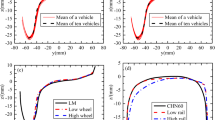Abstract
The worn status of wheel/rail profiles could change the wheel-rail contact and influence the wear rates of the wheel and rail. Worn wheel profiles of a Chinese intercity train and the worn rail profile of curved tracks were taken into account in this work. According to the dynamics model of the vehicle, teh wheel-rail three-dimensional steady-state rolling contact model, and the Archard wear model, a new fast calculation method of wheel wear rate was proposed. Simulation results show that obviously severe wear would distribute in the flange when the wheel and rail were worn. The side wear of rail gauge corner will seriously aggravate the wear of new wheel flange. The wear of the wheel is serious for teh worn wheel in the initial phase of service. Therefore, the re-profiling of wheels and rails should be scheduled cooperatively, and the wear of flange in the initial phase of service should addressed.
Similar content being viewed by others
References
M. A. Rezvani, A. Owhadi and F. Niksai, The effect of worn profile on wear progress of rail vehicle steel wheels over curved tracks, Vehicle System Dynamics, 47 (2009) 325–342.
X. Jin, X. Xiao, Z. Wen, J. Guo and M. Zhu, An investigation into the effect of train curving on wear and contact stresses of wheel and rail, Tribology International, 42(3) (2009) 475–490.
K. Matsumoto, Y. Suda, H. Komine, T. Nakai and T. Fujii, A proposal of wheel/rail contact model for friction control, Journal of Mechanical Science and Technology, 19(1) (2005) 437–443.
J. J. Kalker, On the rolling contact of two elastic bodies in presence of dry friction, Ph.D. Thesis, Delft University of Technology, Netherlands (1967).
J. J. Kalker, A fast algorithm for the simplified theory of rolling contact, Vehicle System Dynamics, 11 (1982) 1–13.
M. Wiest, E. Kassa, W. Daves, J. C. O. Nielsenc and H. Ossbergerd, Assessment of methods for calculating contact pressure in wheel-rail/switch contact, Wear, 265(9–10) (2006) 1439–1445.
F. Braghin, R. Lewis and R. S. Dwyer-Joyce, A mathematical model to predict railway wheel profile evolution due to wear, Wear, 261 (2006) 1253–1264.
Q. Xiao, Z. Luo, X. Xu, J. Zheng and S. Cheng, Research on influence of harmonic wear wheel on wheel/rail contact geometry of high-speed train, Journal of Mechanical Science and Technology, 33(2) (2019) 537–544.
N. Nakano and Y. Terumichi, Numerical analysis for coupled train considering 3D wheel/rail contact geometry, Journal of Mechanical Science and Technology, 29(7) (2015) 2677–2683.
N. N. Maksimova and R. V. Namm, Finite-element solution of a model mechanical problem with friction based on a smoothing Lagrange multiplier method, Computational Mathematics and Mathematical Physics, 52 (2012) 20–30.
X. Zhao and Z. Li, The solution of frictional wheel-rail rolling contact with a 3D transient finite element model: validation and error analysis, Wear, 271(1–2) (2011) 444–452.
M. Pletz, W. Daves, W. Yao, W. Kubin and S. Scheriau, Multiscale finite element modeling to describe rolling contact fatigue in a wheel-rail test rig, Tribology International, 80 (2014) 147–155.
Z. Wen, L. Wu, W. Li, X. Jin and M. Zhu, Three-dimensional elastic-plastic stress analysis of wheel-rail rolling contact, Wear, 271(1–2) (2011) 426–436.
A. Sladkowski and M. Sitarz, Analysis of wheel-rail interaction using FE software, Wear, 258(7) (2005) 1217–1223.
T. Telliskivi and U. Olofsson, Contact mechanics analysis of measured wheel-rail profiles using the finite element method, Proceedings of the Institution of Mechanical Engineers, Part F: Journal of Rail and Rapid Transit, 215(2) (2001) 65–72.
J. Zhang, S. Sun and X. Jin, Numerical simulation of two-point contact between wheel and rail, Acta Mechanica Solida Sinica, 22(4) (2009) 352–359.
J. Xu, Y. Gao, P. Wang, B. An, J. Chen and R. Chen, Numerical analysis for investigating wheel-rail impact contact in a flange bearing frog crossing, Wear, 450–451 (2020) 243–253.
K. Karttunen, E. Kabo and A. Ekberg, Numerical assessment of the influence of worn wheel tread geometry on rail and wheel deterioration, Wear, 317(1–2) (2014) 77–91.
K. D. Vo, H. T. Zhu, A. K. Tieu and P. B. Kosasih, FE method to predict damage formation on curved track for various worn status of wheel/rail profiles, Wear, 322–323 (2015) 61–75.
M. R. Hou, W. D. Wang, C. Y Chang and L. Li, A study of rail wear on sharp curves in emu maintenance depot, Journal of the China Railway Society, 40(3) (2018) 45–50.
C. Y. Chang, C. G. Wang and Y. Jin, Study on numerical method to predict wheel/rail profile evolution due to wear, Wear, 269(3–4) (2010) 167–173.
J. F. Archard, Contact and rubbing of flat surfaces, Journal of Applied Physics, 24(8) (1953) 981–988.
M. F. Ashby and S. C. Lim, Wear-mechanism maps, Scripta Metallurgica Et Materiala, 24(5) (1990) 805–810.
T. Jendel and M. Berg, Prediction of wheel profile wear: methodology and verification, Vehicle System Dynamics, 37 (2002) 502–513.
R. Lewis and U. Olofsson, Mapping rail wear regimes and transitions, Wear, 257(7–8) (2004) 721–729.
Acknowledgments
This work was supported by the National Natural Science Foundation of China (Grant No. 51805374) and the Key R & D Program of the Ministry of Science and Technology (Grant No. 208YFB1201603-08). The authors would like to express their appreciation to these agencies.
Author information
Authors and Affiliations
Corresponding author
Additional information
Recommended by Editor No-cheol Park
Kou Jie is a Ph.D. candidate at the Institution of Rail Transit, Tongji University, Shanghai, China. He received his Bachelor’s degree in Mechanical Engineering from Southwest University. His research interests include railway vehicle dynamics and wheel-rail contact analysis.
Hechao Zhou is an Assistant Professor of the Institution of Rail Transit, Tongji University, Shanghai, China. He received his Ph.D. degree in Mechanical Engineering from Technische Universität Berlin. His research interests include railway vehicle dynamics and control.
Rights and permissions
About this article
Cite this article
Kou, J., Zhang, J., Zhou, H. et al. Effect of the worn status of wheel/rail profiles on wheel wear over curved tracks. J Mech Sci Technol 35, 945–954 (2021). https://doi.org/10.1007/s12206-021-0207-y
Received:
Revised:
Accepted:
Published:
Issue Date:
DOI: https://doi.org/10.1007/s12206-021-0207-y



